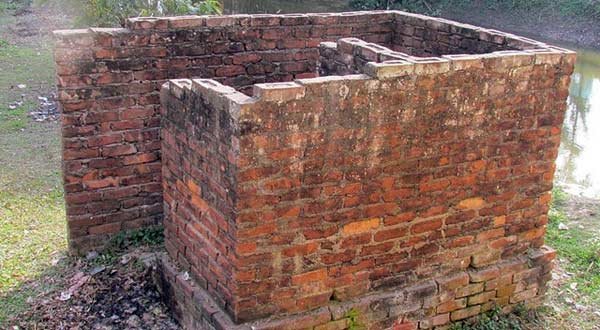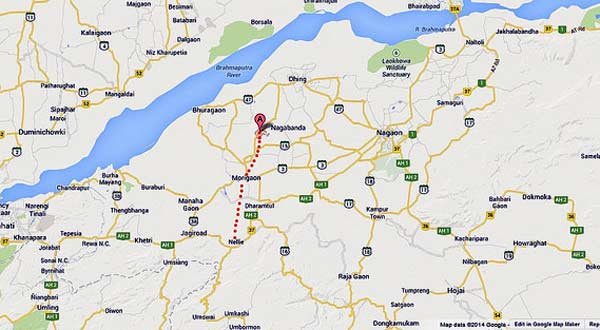

The Assamese intelligentsia continues to live in denial of the massacre of Muslims from Nagabanda to Nellie three decades ago
ABDUL KALAM AZAD
MORIGAON, Assam, Feb 22 (TCN) — The Nagabanda High School is one of the oldest educational institutes of Morigaon district of Assam. The school is situated near the Nagabanda Bazar, about 15 KMs from the district headquarters. The healthy rural market, the nicely planted trees at Nagabanda Junior College, huge playground with pavilion and the green agricultural fields surrounding the area make it scenic and beautiful. But who knows Nagabanda is carrying a huge amount of pain and agony?
On 16th February’1983, 109 helpless people were brutally killed in a relief camp at Nagabanda High School. The people of the adjoining villages were instructed by the peace committee of civil administration and police administration to take shelter in the relief camp on 16th February 1983 to escape the violent attacks of the agitators of Assam Movement.
A large numbers of people including women and children from surrounding villages took shelter in the school. At around 10’o clock in the morning, a huge mob led by policemen, attacked the school. The police indiscriminately fired while the frightened people closed the doors and windows of the school.
Then the agitators set school on fire. Some of the people tried to escape through the windows in the back; some of them climbed the trees near the school. But they couldn’t escape. The mob killed them while on tree with sharp and long weapons. In total, 109 bodies were recovered with another few hundreds getting away with injuries.
The Nagabanda massacre is a watershed in Assam’s history as it answers many questions in relation to the infamous Nellie massacre. The Nagabanda massacre was carried out two days before the infamous Nellie massacre.
In both the cases many of the perpetrators and victims were from common communities. The Bengal origin Muslim-dominated Nagabanda is surrounded by the villages of Tiwa (lalung), Koch and Nath-Jogi communities.

In the case of Nellie, Tiwas were the main perpetrators and Muslims were the victims. Here also the Muslims were in the victims and the involvement of Tiwas in violence was apparent. In both cases, Muslims were victimized by the agitators as they had participated in the election.
The Nagabanda incident was a warning signal for the civil as well as police administration to avert the Nellie massacre which claimed 1600 lives officially, the unofficial figure is more than five thousand.
Evidently, the police and administration were hand in glove with the agitators. One of the victims of police brutality, Abdul Majid, a school teacher from Nagabanda described how after returning from election duty he found his home deserted. After the Nagabanda High School carnage, people had left their houses.
Abdul Majid decided to return to the police station from where he was sent to election duty. He stopped a vehicle carrying police personnel and requested them to take him to police station.
In response, police brutally beat him up; snatched golden bangles of wife and Rs. 800/- from his pocket. He took off his skull cap to show the wound mark on his head. Along with him two other commuters, postmaster of the local post office and the peon, were also beaten up. The police even broke a leg of the postmaster.
Speaking of the police and civil administration’s complicity in the attacks against Muslims, Prof. Sanjoy Hazarika later wrote, “(government officers) defied the official orders and courted arrest, demanding the ouster of the aliens. If it was not xenophobia, then it was patriotism of a very jingoistic quality.”
But were those Muslims really aliens, people who had their roots in this land for generations? Or is this an attempt to romanticize those atrocities?
Though being a student of social science and having keen interest in the Assamese movement, I had very little information about the gruesome genocide until I reached Nagabanda and interacted with the survivors.
Senior journalist Samudhra Gupta Kashyp’s comments about the Nellie massacre come to mind. He was speaking in a conversation called “Can today’s society change the media?” organised by Thumb Print Magazine at Tata Institute of Social Sciences, Guwahati. He informed the gathering that, Assam Tribune, the leading English Daily from Guwahati had had an editorial meeting and decided not to publish a single photo of Nellie massacre!
Though I perceived it in a different perspective, but today, I am seeing the other side of such decision. Hundred and nine lives were brutally hacked to death during broad day light by the agitators with the active participation of government machinery but the people of the state as well as in outside remain in the dark. No doubt media played a very biased and cruel role during the agitation. The fascist characteristics of the agitation were also responsible for such gross violation of professional ethic of journalism. Sabita Goswami wrote in her autobiography that she was summoned by the then AASU leader Atul Bora. When she visited AASU office, Atul Bora showed a photocopy of her article and said “If an Assamese writes in this manner, it is equivalent to going against Assam’s interests”. Foreign journalists were also not allowed to enter Assam for a certain period of time during the movement.
This biasness still continues and has been grounded to other domains as well. If we analyse the news and views on Nellie massacre, it becomes very much clear that the academicians and researchers were not free from the ethnocentric biasness. While analysing the Nellie massacre Sanjoy Hazarika writes, “They become dependent on the others. Their own shortsightedness is reflected everyday when they contemplate their former tenants as owners of this ancestral land. The rage becomes deeper, blinding those in its grip to their own follies”.
Many academicians like Prof. Hazarika saw land alienation as the primary cause of the Nellie massacre. But when Japanese researcher Makiko Kimura asked both the attackers from Tiwa and victims from Muslims of Bengali origins, commonly known as Miya, about the cause of the massacre, nobody mentioned the land alienation as a reason.
When I categorically asked one 78-year old Mafiz Uddin Ahmed, who lost ten of his family members including his mother in the Nellie massacre, about the issue of land alienation or land grabbing, his response was quite thought-provoking. He said, “When this land was allotted to us in 1942 by the colonial magistrate against the payment of rupees five, it was a jungle. Our family came to Nellie from Nogaon (Earlier Nowgong) and cleared the land for cultivation.”
It leaves no one in doubt that the Muslims had not grabbed the land of Tiwas or had alienated them from their land. But they got a jungle against payment from the British government as per the policy of the colonial administration. He holds leaders of the Assam Movement responsible for the massacre and says that the AASU and the subsequent AGP government declared the attackers who died during the massacre as martyrs. The so-called martyrs’ families were compensated with Rs. 25000 while the victims who lost their lives for participating in the democratic process called election were not declared as martyr and provided with mere Rs. 5000 as compensation!
Then what is the reason behind justifying riots, taking innocent human lives and gross violation of civil, political and human rights? Or why do we try to cover up injustice committed on a marginalized community? Why we can’t digest the historical fact that these so-called Miyas were brought to Assam from another province of colonial India under administrative patronage?